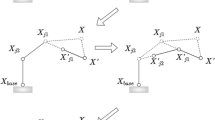Abstract
This paper presents a novel low cost design for a 3-RRR Planar Parallel Manipulator (PPM). These manipulators proved their superiority over serial manipulators due to their speed, precision and smaller work space where the work space area is accounted for in the design to ensure that the robot is performing its task in a smooth and simple way without getting into any singularity points. The challenge with PPM is to obtain the kinematic constraint equations of the manipulator due to their complex non-linear behavior. Screw theory is a new approach that is used to compute the direct and inverse kinematics based on the relation between each link and its’ predecessor. The design is then inserted into ADAMS to study its dynamical behavior and to obtain a data set that would be used in analyzing the system in MATLAB. A Neuro-Fuzzy Inference System (NFIS) model was constructed in order to predict the end-effector position inside the work space and it is tuned with Particle swarm optimization (PSO) and Genetic algorithm (GA).
Access this chapter
Tax calculation will be finalised at checkout
Purchases are for personal use only
Similar content being viewed by others
References
Angel, L., Pérez, M., Díaz-Quintero, C., Mendoza, C.: Adams/matlab co-simulation: dynamic systems analysis and control tool. In: Applied Mechanics and Materials, vol. 232, pp. 527–531 (2012)
Arora, J.: Genetic algorithms for optimum design. In: Introduction to Optimum Design, pp. 643–655 (2004)
Azar, A.T., Zhu, Q., Khamis, A., Zhao, D.: Control design approaches for parallel robot manipulators: a review. Int. J. Model. Identif. Control 28(3), 199–211 (2017)
Azar, A.T., Aly, A.M., Sayed, A.S., Radwan, M.E., Ammar, H.H.: Neuro-fuzzy system for 3-DOF parallel robot manipulator. In: 2019 Novel Intelligent and Leading Emerging Sciences Conference (NILES), vol. 1, pp. 1–5 (2019)
Azar, A.T., Ali, N., Makarem, S., Diab, M.K., Ammar, H.H.: Design and implementation of a ball and beam PID control system based on metaheuristic techniques. In: Hassanien, A.E., Shaalan, K., Tolba, M.F. (eds.) Proceedings of the International Conference on Advanced Intelligent Systems and Informatics, pp. 313–325. Springer, Cham (2020)
Azar, A.T., Sayed, A.S., Shahin, A.S., Elkholy, H.A., Ammar, H.H.: PID controller for 2-DOFS twin rotor MIMO system tuned with particle swarm optimization. In: Hassanien, A.E., Shaalan, K., Tolba, M.F. (eds.) Proceedings of the International Conference on Advanced Intelligent Systems and Informatics, pp. 229–242. Springer, Cham (2020)
Boudreau, R., Nokleby, S.: Force optimization of kinematically-redundant planar parallel manipulators following a desired trajectory. Mech. Mach. Theory 56, 138–155 (2012)
Goldberg, D.E.: Genetic Algorithms in Search, Optimization and Machine Learning, 1st edn. Addison-Wesley/Longman Publishing Co., Inc., Upper Saddle River (1989)
Gough, V.: Contribution to discussion of papers on research in automobile stability, control and tyre performance. Proc. Auto Div. Inst. Mech. Eng. 171, 392–395 (1957)
Hamdoun, O., El Bakkali, L., Baghli, F.Z.: Analysis and optimum kinematic design of a parallel robot. Procedia Eng. 181, 214–220 (2017)
Kubela, T., Pochyly, A., Singule, V.: Advanced tools for multi-body simulation and design of control structures applied in robotic system development. Solid State Phenom. 164, 387–391 (2010)
Kucuk, S.: Dexterous workspace optimization for a new parallel robot manipulator. J. Mech. Robot. 10(6), 8 p. (2018). Article no. 064503
Liu, C., Cao, G., Qu, Y.: Safety analysis via forward kinematics of delta parallel robot using machine learning. Saf. Sci. 117, 243–249 (2019)
Luces, M., Mills, J.K., Benhabib, B.: A review of redundant parallel kinematic mechanisms. J. Intell. Robot. Syst. 86(2), 175–198 (2017)
Merlet, J.: Parallel Robots, vol. 74. Springer, Sophia-Antipolis (2012)
Mitchell, M., Toroczkai, Z.: Complexity: a guided tour. Phys. Today 63, 47 (2010)
Müller, A.: Redundant actuation of parallel manipulators. In: Parallel Manipulators, Towards New Applications. IntechOpen (2008)
Pierrot, F., Reynaud, C., Fournier, A.: Delta: a simple and efficient parallel robot. Robotica 8(2), 105–109 (1990)
Seibel, A., Schulz, S., Schlattmann, J.: On the direct kinematics problem of parallel mechanisms. J. Robot. 2018, 1–9 (2018). Article ID 2412608. https://doi.org/10.1155/2018/2412608
Shi, H., Su, H.J.: An analytical model for calculating the workspace of a flexure hexapod nanopositioner. J. Mech. Robot. 5(4), 041,009 (2013)
Shi, H., Su, H.J., Dagalakis, N.: A stiffness model for control and analysis of a mems hexapod nanopositioner. Mech. Mach. Theory 80, 246–264 (2014)
Talaslioglu, T.: Optimal design of steel skeletal structures using the enhanced genetic algorithm methodology. Front. Struct. Civ. Eng. 13(4), 863–889 (2019)
Xie, F., Liu, X.J.: Design and development of a high-speed and high-rotation robot with four identical arms and a single platform. J. Mech. Robot. 7(4), 041,015 (2015)
Xu, Q., Li, Y.: A 3-PRS parallel manipulator control based on neural network. In: Liu, D., Fei, S., Hou, Z.G., Zhang, H., Sun, C. (eds.) Advances in Neural Networks - ISNN 2007, pp. 757–766. Springer, Heidelberg (2007)
Yang, X.S.: Optimization and Metaheuristic Algorithms in Engineering, pp 1–23 (2013)
Zhang, Z., Shao, Z., Wang, L.: Improving the kinematic performance of a planar 3-RRR parallel manipulator through actuation mode conversion. Mech. Mach. Theory 130, 86–108 (2018)
Author information
Authors and Affiliations
Corresponding author
Editor information
Editors and Affiliations
Rights and permissions
Copyright information
© 2020 Springer Nature Switzerland AG
About this paper
Cite this paper
Sayed, A.S., Azar, A.T., Ibrahim, Z.F., Ibrahim, H.A., Mohamed, N.A., Ammar, H.H. (2020). Deep Learning Based Kinematic Modeling of 3-RRR Parallel Manipulator. In: Hassanien, AE., Azar, A., Gaber, T., Oliva, D., Tolba, F. (eds) Proceedings of the International Conference on Artificial Intelligence and Computer Vision (AICV2020). AICV 2020. Advances in Intelligent Systems and Computing, vol 1153. Springer, Cham. https://doi.org/10.1007/978-3-030-44289-7_29
Download citation
DOI: https://doi.org/10.1007/978-3-030-44289-7_29
Published:
Publisher Name: Springer, Cham
Print ISBN: 978-3-030-44288-0
Online ISBN: 978-3-030-44289-7
eBook Packages: Intelligent Technologies and RoboticsIntelligent Technologies and Robotics (R0)




